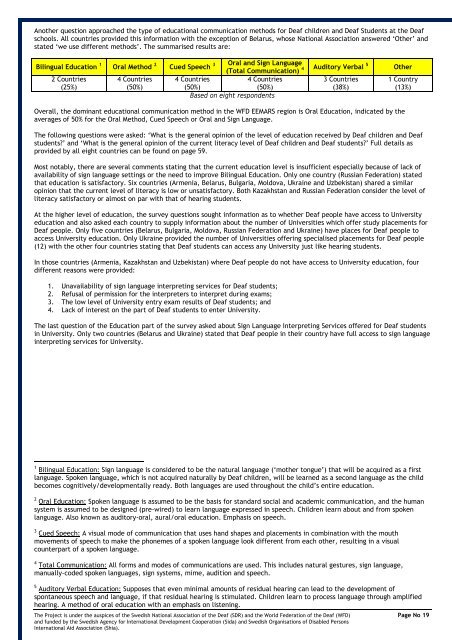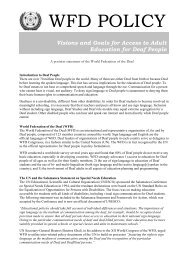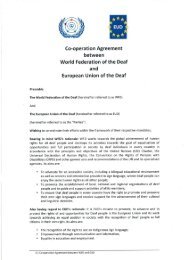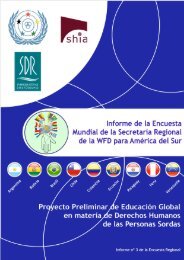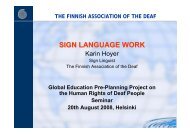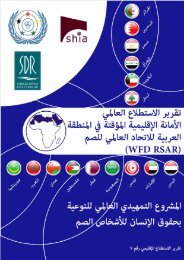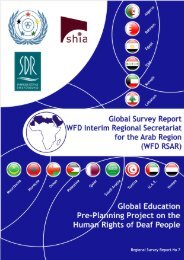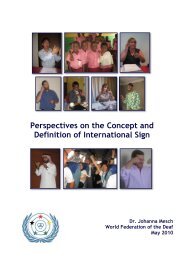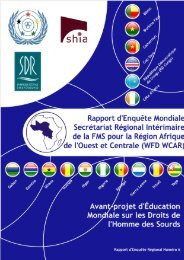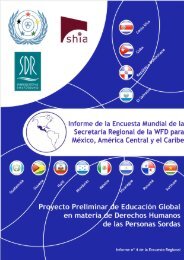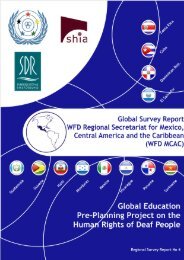Page No 1 - World Federation of the Deaf
Page No 1 - World Federation of the Deaf
Page No 1 - World Federation of the Deaf
You also want an ePaper? Increase the reach of your titles
YUMPU automatically turns print PDFs into web optimized ePapers that Google loves.
Ano<strong>the</strong>r question approached <strong>the</strong> type <strong>of</strong> educational communication methods for <strong>Deaf</strong> children and <strong>Deaf</strong> Students at <strong>the</strong> <strong>Deaf</strong><br />
schools. All countries provided this information with <strong>the</strong> exception <strong>of</strong> Belarus, whose National Association answered ‘O<strong>the</strong>r’ and<br />
stated ‘we use different methods’. The summarised results are:<br />
Bilingual Education 1 Oral Method 2 Cued Speech 3 Oral and Sign Language<br />
(Total Communication) 4 Auditory Verbal 5 O<strong>the</strong>r<br />
2 Countries<br />
(25%)<br />
4 Countries<br />
(50%)<br />
4 Countries<br />
(50%)<br />
4 Countries<br />
(50%)<br />
3 Countries<br />
(38%)<br />
1 Country<br />
(13%)<br />
Based on eight respondents<br />
Overall, <strong>the</strong> dominant educational communication method in <strong>the</strong> WFD EEMARS region is Oral Education, indicated by <strong>the</strong><br />
averages <strong>of</strong> 50% for <strong>the</strong> Oral Method, Cued Speech or Oral and Sign Language.<br />
The following questions were asked: ‘What is <strong>the</strong> general opinion <strong>of</strong> <strong>the</strong> level <strong>of</strong> education received by <strong>Deaf</strong> children and <strong>Deaf</strong><br />
students?’ and ‘What is <strong>the</strong> general opinion <strong>of</strong> <strong>the</strong> current literacy level <strong>of</strong> <strong>Deaf</strong> children and <strong>Deaf</strong> students?’ Full details as<br />
provided by all eight countries can be found on page 59.<br />
Most notably, <strong>the</strong>re are several comments stating that <strong>the</strong> current education level is insufficient especially because <strong>of</strong> lack <strong>of</strong><br />
availability <strong>of</strong> sign language settings or <strong>the</strong> need to improve Bilingual Education. Only one country (Russian <strong>Federation</strong>) stated<br />
that education is satisfactory. Six countries (Armenia, Belarus, Bulgaria, Moldova, Ukraine and Uzbekistan) shared a similar<br />
opinion that <strong>the</strong> current level <strong>of</strong> literacy is low or unsatisfactory. Both Kazakhstan and Russian <strong>Federation</strong> consider <strong>the</strong> level <strong>of</strong><br />
literacy satisfactory or almost on par with that <strong>of</strong> hearing students.<br />
At <strong>the</strong> higher level <strong>of</strong> education, <strong>the</strong> survey questions sought information as to whe<strong>the</strong>r <strong>Deaf</strong> people have access to University<br />
education and also asked each country to supply information about <strong>the</strong> number <strong>of</strong> Universities which <strong>of</strong>fer study placements for<br />
<strong>Deaf</strong> people. Only five countries (Belarus, Bulgaria, Moldova, Russian <strong>Federation</strong> and Ukraine) have places for <strong>Deaf</strong> people to<br />
access University education. Only Ukraine provided <strong>the</strong> number <strong>of</strong> Universities <strong>of</strong>fering specialised placements for <strong>Deaf</strong> people<br />
(12) with <strong>the</strong> o<strong>the</strong>r four countries stating that <strong>Deaf</strong> students can access any University just like hearing students.<br />
In those countries (Armenia, Kazakhstan and Uzbekistan) where <strong>Deaf</strong> people do not have access to University education, four<br />
different reasons were provided:<br />
1. Unavailability <strong>of</strong> sign language interpreting services for <strong>Deaf</strong> students;<br />
2. Refusal <strong>of</strong> permission for <strong>the</strong> interpreters to interpret during exams;<br />
3. The low level <strong>of</strong> University entry exam results <strong>of</strong> <strong>Deaf</strong> students; and<br />
4. Lack <strong>of</strong> interest on <strong>the</strong> part <strong>of</strong> <strong>Deaf</strong> students to enter University.<br />
The last question <strong>of</strong> <strong>the</strong> Education part <strong>of</strong> <strong>the</strong> survey asked about Sign Language Interpreting Services <strong>of</strong>fered for <strong>Deaf</strong> students<br />
in University. Only two countries (Belarus and Ukraine) stated that <strong>Deaf</strong> people in <strong>the</strong>ir country have full access to sign language<br />
interpreting services for University.<br />
1 Bilingual Education: Sign language is considered to be <strong>the</strong> natural language (‘mo<strong>the</strong>r tongue’) that will be acquired as a first<br />
language. Spoken language, which is not acquired naturally by <strong>Deaf</strong> children, will be learned as a second language as <strong>the</strong> child<br />
becomes cognitively/developmentally ready. Both languages are used throughout <strong>the</strong> child’s entire education.<br />
2 Oral Education: Spoken language is assumed to be <strong>the</strong> basis for standard social and academic communication, and <strong>the</strong> human<br />
system is assumed to be designed (pre-wired) to learn language expressed in speech. Children learn about and from spoken<br />
language. Also known as auditory-oral, aural/oral education. Emphasis on speech.<br />
3 Cued Speech: A visual mode <strong>of</strong> communication that uses hand shapes and placements in combination with <strong>the</strong> mouth<br />
movements <strong>of</strong> speech to make <strong>the</strong> phonemes <strong>of</strong> a spoken language look different from each o<strong>the</strong>r, resulting in a visual<br />
counterpart <strong>of</strong> a spoken language.<br />
4 Total Communication: All forms and modes <strong>of</strong> communications are used. This includes natural gestures, sign language,<br />
manually-coded spoken languages, sign systems, mime, audition and speech.<br />
5 Auditory Verbal Education: Supposes that even minimal amounts <strong>of</strong> residual hearing can lead to <strong>the</strong> development <strong>of</strong><br />
spontaneous speech and language, if that residual hearing is stimulated. Children learn to process language through amplified<br />
hearing. A method <strong>of</strong> oral education with an emphasis on listening.<br />
The Project is under <strong>the</strong> auspices <strong>of</strong> <strong>the</strong> Swedish National Association <strong>of</strong> <strong>the</strong> <strong>Deaf</strong> (SDR) and <strong>the</strong> <strong>World</strong> <strong>Federation</strong> <strong>of</strong> <strong>the</strong> <strong>Deaf</strong> (WFD) <strong>Page</strong> <strong>No</strong> 19<br />
and funded by <strong>the</strong> Swedish Agency for International Development Cooperation (Sida) and Swedish Organisations <strong>of</strong> Disabled Persons<br />
International Aid Association (Shia).


